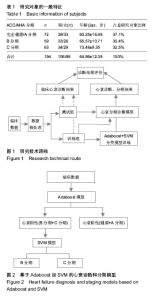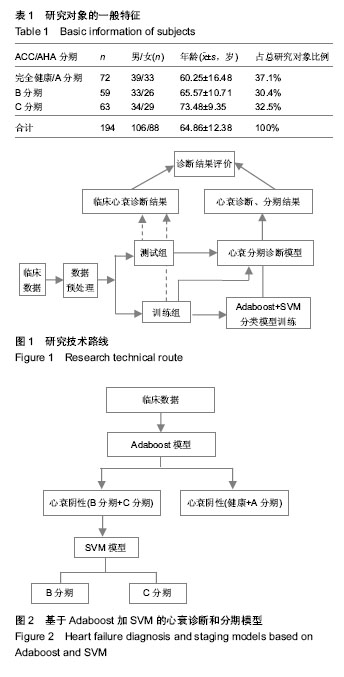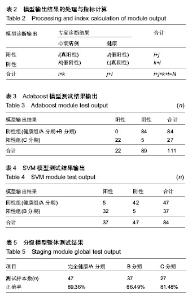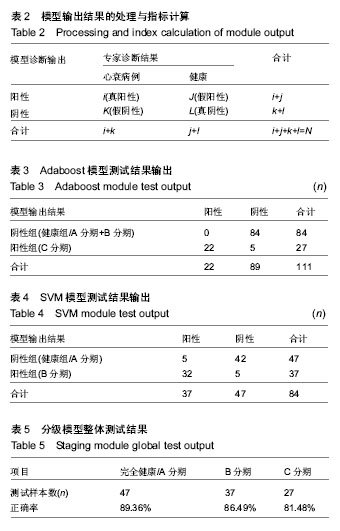| [1] 吴乐舟.心力衰竭的诊断进展[J].同济大学学报:医学版,2011, 32(2):115-119.
[2] Son YJ, Kim HG, Kim EH,et al.Application of support vector machine for prediction of medication adherence in heart failurepatients. Healthc Inform Res. 2010;16(4):253-259.
[3] Verplancke T,Van Looy S,Benoit D,et al.Support vector machine versus logistic regression modeling for prediction of hospital mortality in critically ill patients with haematological malignancies.BMC Med Inform Decis Mak.2008;8:56.
[4] Dassen W,Gorgels A,Berendsen A,et al.Guideline assessment and implementation in congestive heart failure. Comput Cardiol.2003;331-334.
[5] Yu W,Liu T,Valdez R,et al.Application of support vector machine modeling for prediction of common diseases: the case of diabetes and prediabetes. BMC Med Inform Decis Mak.2010;10:16.
[6] Yu SN,Lee MY.Conditional mutual information-based feature selection for congestive heart failure recognition using heart rate variability. Comput Methods Programs Biomed.2012; 108(1):299-309
[7] Thurston RC,Matthews KA,Hernandez J,et al.Improving the performance of physiologic hot flash measures with support vector machines.Psychophysiology. 2009;46:285-292.
[8] Toh CT,Jackson B,Gascard DJ,et al.Barriers to medication adherence in chronic heart failure patients during home visits.J Pharm Pract Res.2010;40:27-30.
[9] Riegel B,Moser DK,Anker SD,et al.State of the science: promoting self-care in persons with heart failure: a scientific statement from the American Heart Association. Circulation. 2009;120(12):1141-1163.
[10] Rud S,Yang JS.A support vector machine (SVM) classification approach to heart murmur detection.Lect Notes Comp Sci. 2010;6004:52-59.
[11] Choi K,Chung S,Rhee H,et al.Classification and sequential pattern analysis for improving managerial efficiency and providing better medical service in public healthcare centers. Healthc Inform Res.2010;16:67-76.
[12] Kim BM,Kang BY,Kim HG,et al.Prognosis prediction for class III malocclusion treatment by feature wrapping method.Angle Orthod.2009;79:683-691.
[13] Choi JP,Han TH,Park RW.A hybrid Bayesian network model for predicting breast cancer prognosis.J Korean Soc Med Inform.2009;15:49-57.
[14] Ubeyli ED.ECG beats classification using multiclass support vector machines with error correcting output codes.Dig Signal Process.2007;17(3):675-684.
[15] Li CM,Du YC,Wu JX,et al. Synchronizing chaotification with support vector machine and wolfpack search algorithm for estimation of peripheral vascular occlusionin diabetes mellitus.Biomed Signal Process Control.2014;9:45-55.
[16] Gbaoui L,Kaniusa E.Decomposition of photoplethysmographical arterialpulse waves by independent component analysis: possibilities and limitations.LNEE. 2010; 55:1100-1119.
[17] Lin CH,Chen YF,Du YC,et al.Chaos synchronization detector combining radial basis network for estimation of lower limb peripheralvascular occlusive disease. LNCS.2010;6165: 126-136.
[18] Yang GQ,Ren YZ,Pan Q,et al.A heart failure diagnosis model based on support vector machine. Biomedical Engineering and Information (BMEI), 3rd International Conference, 2010: 1105-1108.
[19] Du YC,Lin CH.Adaptive network-based fuzzy inference system for assessment of lower limb peripheral vascular occlusive disease.J Med Syst.2012;36(1):301-310.
[20] Kearns M,Valiant LG.Cryptographic Limitations on Learning Boolean Formulae and Finite Automata.J ACM.1994;41(1): 67-95.
[21] Freund Y,Schapire RE.A Decision-Theoretic Generalization of On-Line Learning and an Application to Boosting.J Comput Syst Sci.1997;55(1):119-139.
[22] Wu J,Roy J,Stewart WF.Prediction Modeling Using HER Data Challenges,Strategies,and a Comparison of Machine Learning Approaches.Med Care.2010;48(6 Suppl):S106-113.
[23] Miller RA.Computer-assisted diagnostic decision support: history,challenges and possible paths forward.Adv Health Sci Educ Theory Pract.2009;Suppl 1:89-106.
[24] Hong Y,Shore KA.Power loss resilience in laser diode-based optical chaoscommunications systems.J Lightwave Technol. 2010;28(3):270-276.
[25] Zhang X,Khadra A,Yang D,et al.Unified impulsive fuzzy-model-basedcontrollers for chaotic systems with parameter uncertainties via LMI.Com-munication in Nonlinear Science and Numerical Simulation.2010;15(1):105-144.
[26] 朱悦,吴建华,方颖.SVM在冠心病分类预测中的应用研究[J].生物医学工程学杂志,2013,30(6):1180-1185.
[27] Gazi V,Passin KM.Particle swarm optimization In swarm stability and optimization.Berlin Heidelberg:Springer,2011: 251-279.
[28] Deng NY,Tian YJ.The new method of data mining:support vector machine.Beijing:Science Press,2004.
[29] Hongzong S,Tao W,Xiaojun Y,et al.Support vector machines classification for discriminating coronary heart disease patients from non-coronary heart disease. West Indian Med J.2007;56(5):451-457.
[30] Xue H,Chen SC,Yang Q.Structural regularized support vector machine: a framework for structural large margin classifier. IEEE Trans Neural Netw. 2011;22(4):573–587.
[31] Liu G,Wang L,Wang Q,et al.A New Approach to Detect Congestive Heart Failure Using Short-Term Heart Rate Variability Measures.PLoS One.2014;9(4):e93399.
[32] Hogg K,Swedberg K,McMurray J.Heart failure with preserved left ventricular systolic function; epidemiology, clinical characteristics, and prognosis. J Am Coll Cardiol.2004; 43: 317-327.
[33] Zhao L,Vaccarino V,Wilson PW.Predictors of incident heart failure in a large insured population: a one million person-year follow-up study.Circ Heart Fail.2010;3:698-705.
[34] Zile MR,Massie BM,Carson PE.Body mass index and adverse cardiovascular outcomes in heart failure patients with preserved ejection fraction: results from the Irbesartan in Heart Failure with Preserved Ejection Fraction (I-PRESERVE) trial. Circ Heart Fail.2011;4:324-331.
[35] Wang TJ,Tu JV,Levy D.Relation of disease pathogenesis and risk factors to heart failure with preserved or reduced ejection fraction: insights from the Framingham Heart Study of the National Heart, Lung, and Blood Institute. Circulation.2009; 119:3070-3077. |



